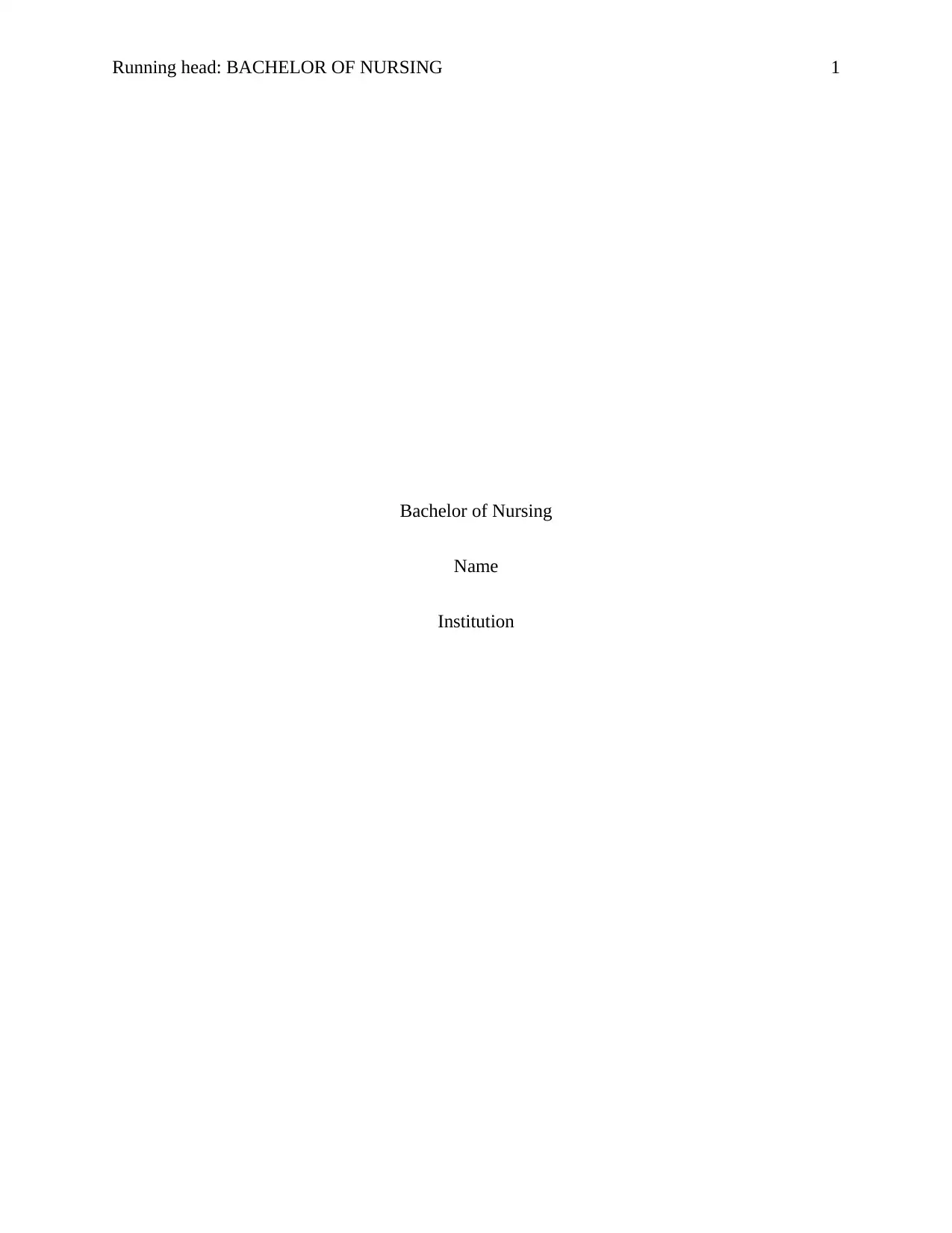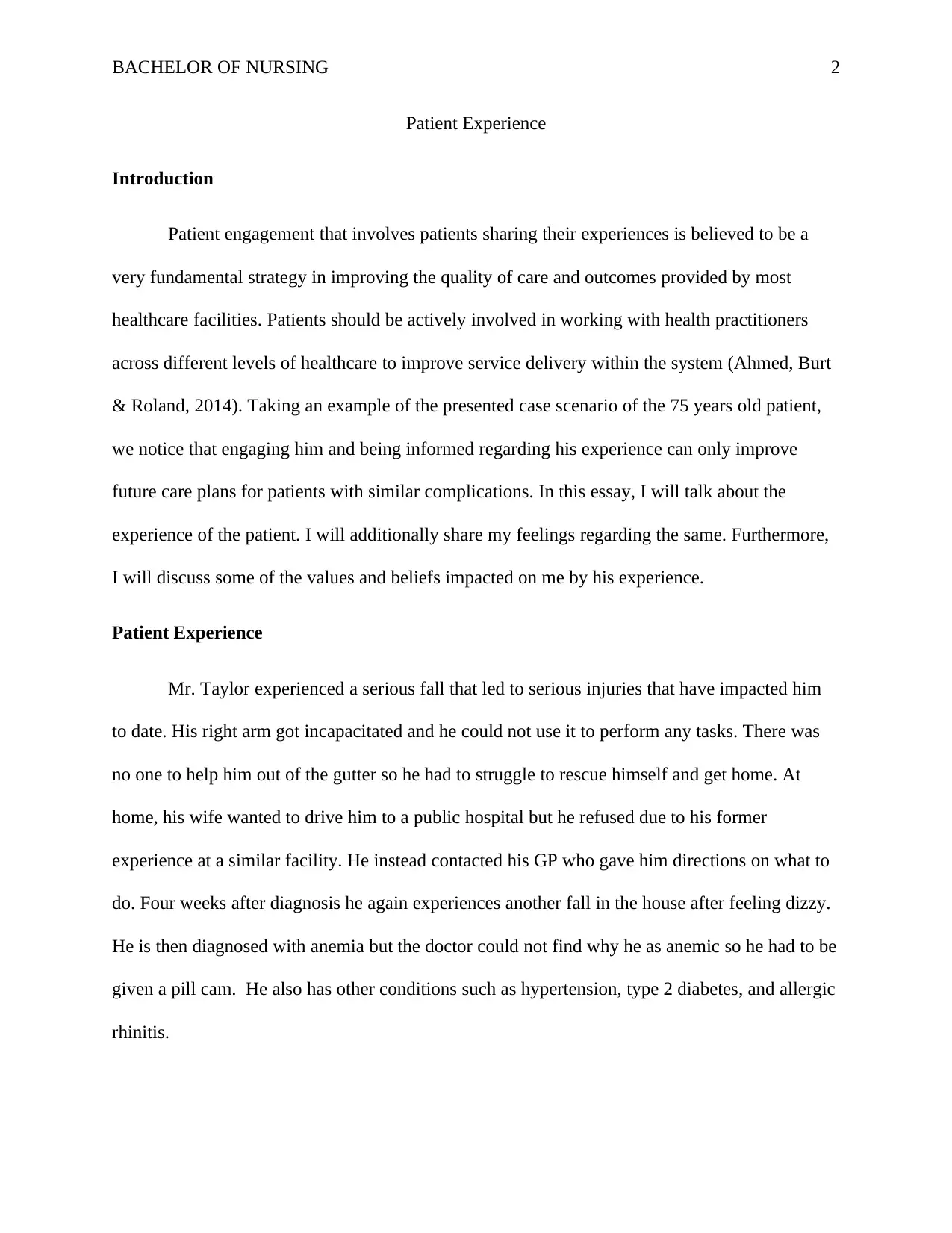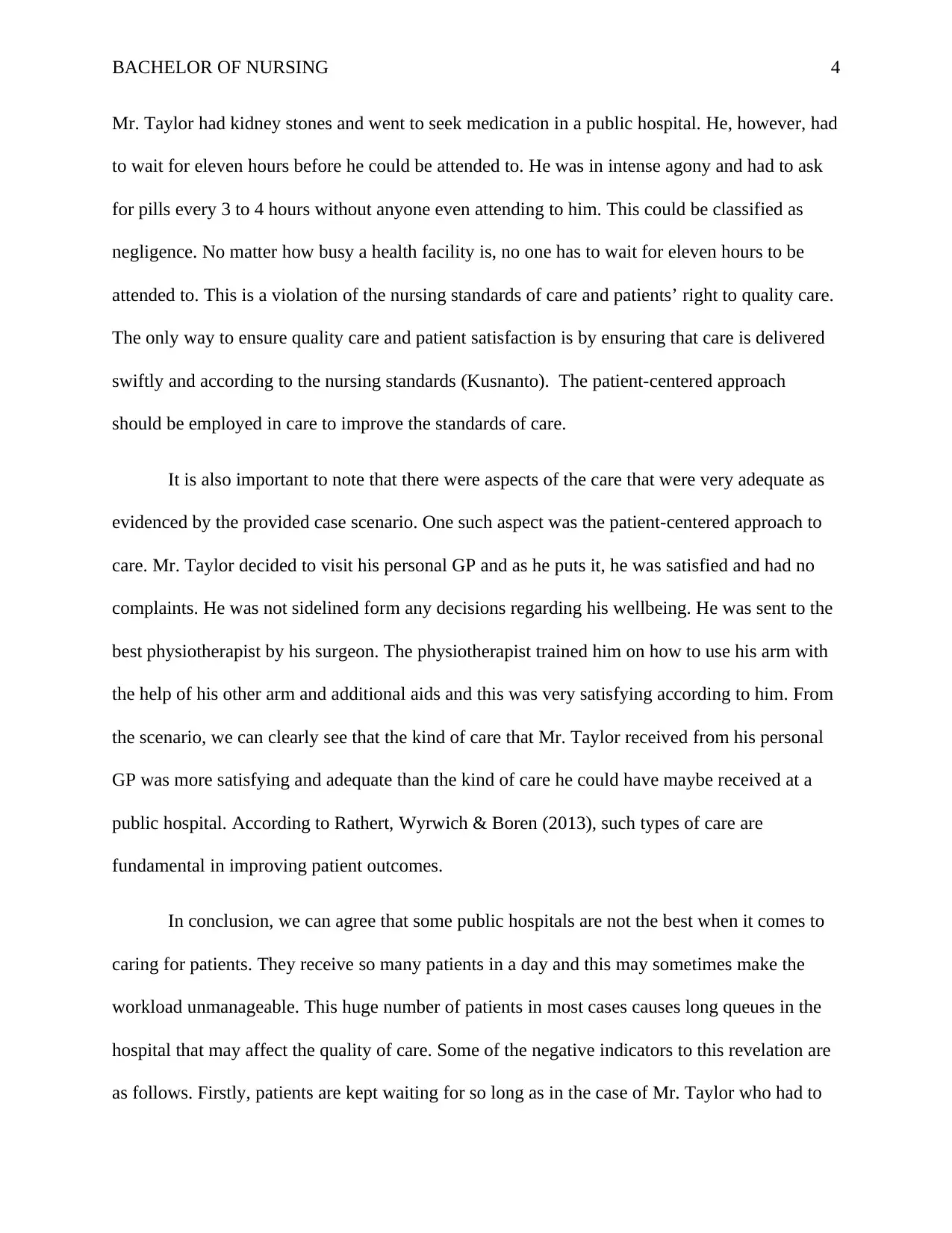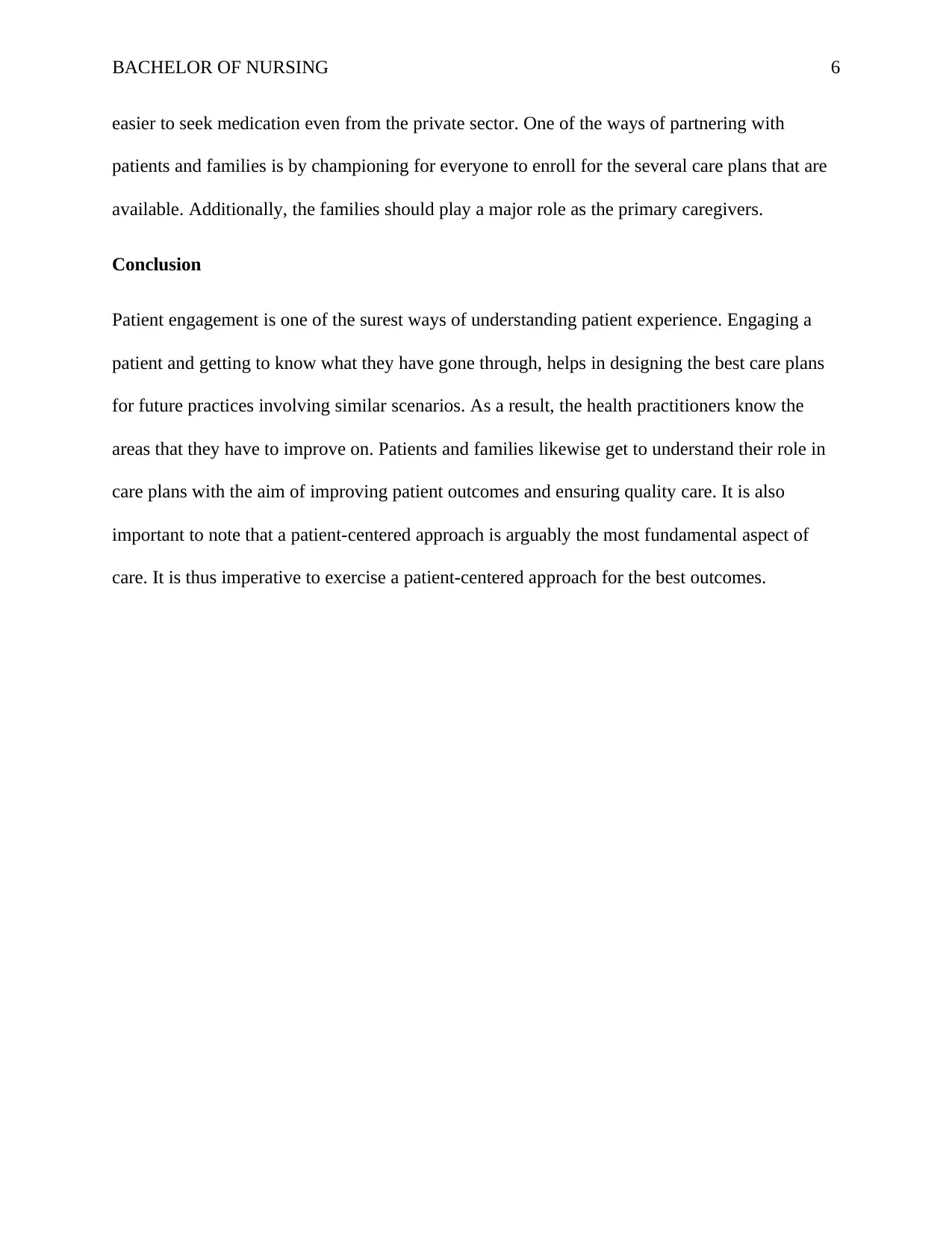NUR1201 - Patient Experience in Care: Reflection on a Case Scenario
VerifiedAdded on 2023/06/03
|7
|1866
|209
Essay
AI Summary
This essay reflects on the patient experience of Mr. Taylor, a 75-year-old patient who experienced a serious fall and subsequent health issues. The reflection focuses on the impact of patient experience on care quality, the importance of patient-centered approaches, and the role of family support. It discusses the perceived inadequacies in public hospitals, such as long waiting times, and contrasts them with the more satisfactory care received from a personal GP. The essay concludes by proposing an action plan to address overcrowding and negligence in public hospitals, emphasizing the need for increased capacity, affordable care plans, and the involvement of families as primary caregivers. The importance of patient engagement and a patient-centered approach in improving healthcare outcomes is underscored.

Running head: BACHELOR OF NURSING 1
Bachelor of Nursing
Name
Institution
Bachelor of Nursing
Name
Institution
Paraphrase This Document
Need a fresh take? Get an instant paraphrase of this document with our AI Paraphraser

BACHELOR OF NURSING 2
Patient Experience
Introduction
Patient engagement that involves patients sharing their experiences is believed to be a
very fundamental strategy in improving the quality of care and outcomes provided by most
healthcare facilities. Patients should be actively involved in working with health practitioners
across different levels of healthcare to improve service delivery within the system (Ahmed, Burt
& Roland, 2014). Taking an example of the presented case scenario of the 75 years old patient,
we notice that engaging him and being informed regarding his experience can only improve
future care plans for patients with similar complications. In this essay, I will talk about the
experience of the patient. I will additionally share my feelings regarding the same. Furthermore,
I will discuss some of the values and beliefs impacted on me by his experience.
Patient Experience
Mr. Taylor experienced a serious fall that led to serious injuries that have impacted him
to date. His right arm got incapacitated and he could not use it to perform any tasks. There was
no one to help him out of the gutter so he had to struggle to rescue himself and get home. At
home, his wife wanted to drive him to a public hospital but he refused due to his former
experience at a similar facility. He instead contacted his GP who gave him directions on what to
do. Four weeks after diagnosis he again experiences another fall in the house after feeling dizzy.
He is then diagnosed with anemia but the doctor could not find why he as anemic so he had to be
given a pill cam. He also has other conditions such as hypertension, type 2 diabetes, and allergic
rhinitis.
Patient Experience
Introduction
Patient engagement that involves patients sharing their experiences is believed to be a
very fundamental strategy in improving the quality of care and outcomes provided by most
healthcare facilities. Patients should be actively involved in working with health practitioners
across different levels of healthcare to improve service delivery within the system (Ahmed, Burt
& Roland, 2014). Taking an example of the presented case scenario of the 75 years old patient,
we notice that engaging him and being informed regarding his experience can only improve
future care plans for patients with similar complications. In this essay, I will talk about the
experience of the patient. I will additionally share my feelings regarding the same. Furthermore,
I will discuss some of the values and beliefs impacted on me by his experience.
Patient Experience
Mr. Taylor experienced a serious fall that led to serious injuries that have impacted him
to date. His right arm got incapacitated and he could not use it to perform any tasks. There was
no one to help him out of the gutter so he had to struggle to rescue himself and get home. At
home, his wife wanted to drive him to a public hospital but he refused due to his former
experience at a similar facility. He instead contacted his GP who gave him directions on what to
do. Four weeks after diagnosis he again experiences another fall in the house after feeling dizzy.
He is then diagnosed with anemia but the doctor could not find why he as anemic so he had to be
given a pill cam. He also has other conditions such as hypertension, type 2 diabetes, and allergic
rhinitis.

BACHELOR OF NURSING 3
I feel that care in public hospitals should be made faster to improve the quality of the
outcome. This could prevent patients from having to wait for long hours before being attended
to. In the presented case scenario, Mr. Taylor refused to go to a public hospital because of his
previous experience. If the patient care at the public hospital was better, then he could not have
waited until the next day to see his personal GP. What if his injuries got worse during the night
leading to deterioration? This is the question that has influenced my thoughts and feelings
because of the fact that he had to wait until the next day when he could instead go to a public
hospital to receive urgent care. According to Epstein & Street (2011), this can only be made
possible if the facilities in public hospitals could be improved and patient-centered care made
better.
From the scenario, it is clear that one of the most important values anyone could have is a
family. This value together with the belief of quality care must have impacted on my feelings
and thoughts about what transpired. These two originate from the strong family bonds that
people share together with the goodwill of caring for others. A family is very important
especially when one of the members falls ill. This is because they are the most immediate
caregivers. Like in the case of Mr. Taylor, his wife was able to drive him to see his GP the next
day and for several other weeks when he still could not use his arms. This goes far to prove how
a family was important to Mr. Taylor after his accident. Additionally, the belief of quality care
must also have affected my feelings after reading that there was some time when Taylor had to
wait in a public hospital for eleven hours before being attended to. Quality care should be
fundamental in any healthcare setting to ensure positive care outcomes.
There were, however, aspects of care that were inadequate in the provided case scenario,
like long waiting hours before attendance by a healthcare practitioner. One example was when
I feel that care in public hospitals should be made faster to improve the quality of the
outcome. This could prevent patients from having to wait for long hours before being attended
to. In the presented case scenario, Mr. Taylor refused to go to a public hospital because of his
previous experience. If the patient care at the public hospital was better, then he could not have
waited until the next day to see his personal GP. What if his injuries got worse during the night
leading to deterioration? This is the question that has influenced my thoughts and feelings
because of the fact that he had to wait until the next day when he could instead go to a public
hospital to receive urgent care. According to Epstein & Street (2011), this can only be made
possible if the facilities in public hospitals could be improved and patient-centered care made
better.
From the scenario, it is clear that one of the most important values anyone could have is a
family. This value together with the belief of quality care must have impacted on my feelings
and thoughts about what transpired. These two originate from the strong family bonds that
people share together with the goodwill of caring for others. A family is very important
especially when one of the members falls ill. This is because they are the most immediate
caregivers. Like in the case of Mr. Taylor, his wife was able to drive him to see his GP the next
day and for several other weeks when he still could not use his arms. This goes far to prove how
a family was important to Mr. Taylor after his accident. Additionally, the belief of quality care
must also have affected my feelings after reading that there was some time when Taylor had to
wait in a public hospital for eleven hours before being attended to. Quality care should be
fundamental in any healthcare setting to ensure positive care outcomes.
There were, however, aspects of care that were inadequate in the provided case scenario,
like long waiting hours before attendance by a healthcare practitioner. One example was when
⊘ This is a preview!⊘
Do you want full access?
Subscribe today to unlock all pages.

Trusted by 1+ million students worldwide

BACHELOR OF NURSING 4
Mr. Taylor had kidney stones and went to seek medication in a public hospital. He, however, had
to wait for eleven hours before he could be attended to. He was in intense agony and had to ask
for pills every 3 to 4 hours without anyone even attending to him. This could be classified as
negligence. No matter how busy a health facility is, no one has to wait for eleven hours to be
attended to. This is a violation of the nursing standards of care and patients’ right to quality care.
The only way to ensure quality care and patient satisfaction is by ensuring that care is delivered
swiftly and according to the nursing standards (Kusnanto). The patient-centered approach
should be employed in care to improve the standards of care.
It is also important to note that there were aspects of the care that were very adequate as
evidenced by the provided case scenario. One such aspect was the patient-centered approach to
care. Mr. Taylor decided to visit his personal GP and as he puts it, he was satisfied and had no
complaints. He was not sidelined form any decisions regarding his wellbeing. He was sent to the
best physiotherapist by his surgeon. The physiotherapist trained him on how to use his arm with
the help of his other arm and additional aids and this was very satisfying according to him. From
the scenario, we can clearly see that the kind of care that Mr. Taylor received from his personal
GP was more satisfying and adequate than the kind of care he could have maybe received at a
public hospital. According to Rathert, Wyrwich & Boren (2013), such types of care are
fundamental in improving patient outcomes.
In conclusion, we can agree that some public hospitals are not the best when it comes to
caring for patients. They receive so many patients in a day and this may sometimes make the
workload unmanageable. This huge number of patients in most cases causes long queues in the
hospital that may affect the quality of care. Some of the negative indicators to this revelation are
as follows. Firstly, patients are kept waiting for so long as in the case of Mr. Taylor who had to
Mr. Taylor had kidney stones and went to seek medication in a public hospital. He, however, had
to wait for eleven hours before he could be attended to. He was in intense agony and had to ask
for pills every 3 to 4 hours without anyone even attending to him. This could be classified as
negligence. No matter how busy a health facility is, no one has to wait for eleven hours to be
attended to. This is a violation of the nursing standards of care and patients’ right to quality care.
The only way to ensure quality care and patient satisfaction is by ensuring that care is delivered
swiftly and according to the nursing standards (Kusnanto). The patient-centered approach
should be employed in care to improve the standards of care.
It is also important to note that there were aspects of the care that were very adequate as
evidenced by the provided case scenario. One such aspect was the patient-centered approach to
care. Mr. Taylor decided to visit his personal GP and as he puts it, he was satisfied and had no
complaints. He was not sidelined form any decisions regarding his wellbeing. He was sent to the
best physiotherapist by his surgeon. The physiotherapist trained him on how to use his arm with
the help of his other arm and additional aids and this was very satisfying according to him. From
the scenario, we can clearly see that the kind of care that Mr. Taylor received from his personal
GP was more satisfying and adequate than the kind of care he could have maybe received at a
public hospital. According to Rathert, Wyrwich & Boren (2013), such types of care are
fundamental in improving patient outcomes.
In conclusion, we can agree that some public hospitals are not the best when it comes to
caring for patients. They receive so many patients in a day and this may sometimes make the
workload unmanageable. This huge number of patients in most cases causes long queues in the
hospital that may affect the quality of care. Some of the negative indicators to this revelation are
as follows. Firstly, patients are kept waiting for so long as in the case of Mr. Taylor who had to
Paraphrase This Document
Need a fresh take? Get an instant paraphrase of this document with our AI Paraphraser

BACHELOR OF NURSING 5
wait for 11 hours. This can only make the situation of the patient worse because in most cases
the patients do not get any care during these waiting hours. Another negative indicator is patient
deterioration which may result from extended hours of neglect thus putting the safety of the
patient at a huge risk. These two indicators may, therefore, be important in directing future
changes in care by ensuring that the interests of the patients are prioritized to improve the quality
of care.
Conversely, private health facilities offer some of the best care in the country. They have
some positive indications like patient-centered care and fast care services. The patient-centered
approach involves the involvement of the patient during decision-making processes that affect
their health (Barry & Edgman-Levitan, 2012). Taking the example of Mr. Taylor, he is involved
when the decision to sew up his torn arm is made unlike the case of his father where the doctor
made the decision of amputating his legs without extensively involving him. This kind of
involvement increases the confidence levels of the patient regarding care. These private facilities
additionally respond to patients swiftly and thus improving the quality of care and patient
outcomes (Manary, Boulding, Staelin & Glickman, 2013). These two indicators may help in
directing future changes in care by striving to ensure that any facility of care employs a patient-
centered approach in their care plans.
Based on the above conclusions drawn from the case scenario I would initiate an action
plan to deal with the issue of overcrowding and negligence in public hospitals. The problem with
public hospitals has always been the high number of patients they receive on a daily basis. And
this is partly due to the high costs witnessed in private hospitals. The best way to address this is
by increasing the capacity of private hospitals and the number of practitioners to meet the WHO
requirements. Additionally, more people should be able to access affordable care plans to make it
wait for 11 hours. This can only make the situation of the patient worse because in most cases
the patients do not get any care during these waiting hours. Another negative indicator is patient
deterioration which may result from extended hours of neglect thus putting the safety of the
patient at a huge risk. These two indicators may, therefore, be important in directing future
changes in care by ensuring that the interests of the patients are prioritized to improve the quality
of care.
Conversely, private health facilities offer some of the best care in the country. They have
some positive indications like patient-centered care and fast care services. The patient-centered
approach involves the involvement of the patient during decision-making processes that affect
their health (Barry & Edgman-Levitan, 2012). Taking the example of Mr. Taylor, he is involved
when the decision to sew up his torn arm is made unlike the case of his father where the doctor
made the decision of amputating his legs without extensively involving him. This kind of
involvement increases the confidence levels of the patient regarding care. These private facilities
additionally respond to patients swiftly and thus improving the quality of care and patient
outcomes (Manary, Boulding, Staelin & Glickman, 2013). These two indicators may help in
directing future changes in care by striving to ensure that any facility of care employs a patient-
centered approach in their care plans.
Based on the above conclusions drawn from the case scenario I would initiate an action
plan to deal with the issue of overcrowding and negligence in public hospitals. The problem with
public hospitals has always been the high number of patients they receive on a daily basis. And
this is partly due to the high costs witnessed in private hospitals. The best way to address this is
by increasing the capacity of private hospitals and the number of practitioners to meet the WHO
requirements. Additionally, more people should be able to access affordable care plans to make it

BACHELOR OF NURSING 6
easier to seek medication even from the private sector. One of the ways of partnering with
patients and families is by championing for everyone to enroll for the several care plans that are
available. Additionally, the families should play a major role as the primary caregivers.
Conclusion
Patient engagement is one of the surest ways of understanding patient experience. Engaging a
patient and getting to know what they have gone through, helps in designing the best care plans
for future practices involving similar scenarios. As a result, the health practitioners know the
areas that they have to improve on. Patients and families likewise get to understand their role in
care plans with the aim of improving patient outcomes and ensuring quality care. It is also
important to note that a patient-centered approach is arguably the most fundamental aspect of
care. It is thus imperative to exercise a patient-centered approach for the best outcomes.
easier to seek medication even from the private sector. One of the ways of partnering with
patients and families is by championing for everyone to enroll for the several care plans that are
available. Additionally, the families should play a major role as the primary caregivers.
Conclusion
Patient engagement is one of the surest ways of understanding patient experience. Engaging a
patient and getting to know what they have gone through, helps in designing the best care plans
for future practices involving similar scenarios. As a result, the health practitioners know the
areas that they have to improve on. Patients and families likewise get to understand their role in
care plans with the aim of improving patient outcomes and ensuring quality care. It is also
important to note that a patient-centered approach is arguably the most fundamental aspect of
care. It is thus imperative to exercise a patient-centered approach for the best outcomes.
⊘ This is a preview!⊘
Do you want full access?
Subscribe today to unlock all pages.

Trusted by 1+ million students worldwide

BACHELOR OF NURSING 7
References
Ahmed, F., Burt, J., & Roland, M. (2014). Measuring patient experience: concepts and
methods. The Patient-Patient-Centered Outcomes Research, 7(3), 235-241.
Barry, M. J., & Edgman-Levitan, S. (2012). Shared decision making—the pinnacle of patient-
centered care. New England Journal of Medicine, 366(9), 780-781.
Epstein, R. M., & Street, R. L. (2011). The values and value of patient-centered care.
Kusnanto, H. Patient-Centered Care. Review of Primary Care Practice and Education (Kajian
Praktik dan Pendidikan Layanan Primer), 1(2), 52-53.
Manary, M. P., Boulding, W., Staelin, R., & Glickman, S. W. (2013). The patient experience and
health outcomes. New England Journal of Medicine, 368(3), 201-203.
Rathert, C., Wyrwich, M. D., & Boren, S. A. (2013). Patient-centered care and outcomes: a
systematic review of the literature. Medical Care Research and Review, 70(4), 351-379.
References
Ahmed, F., Burt, J., & Roland, M. (2014). Measuring patient experience: concepts and
methods. The Patient-Patient-Centered Outcomes Research, 7(3), 235-241.
Barry, M. J., & Edgman-Levitan, S. (2012). Shared decision making—the pinnacle of patient-
centered care. New England Journal of Medicine, 366(9), 780-781.
Epstein, R. M., & Street, R. L. (2011). The values and value of patient-centered care.
Kusnanto, H. Patient-Centered Care. Review of Primary Care Practice and Education (Kajian
Praktik dan Pendidikan Layanan Primer), 1(2), 52-53.
Manary, M. P., Boulding, W., Staelin, R., & Glickman, S. W. (2013). The patient experience and
health outcomes. New England Journal of Medicine, 368(3), 201-203.
Rathert, C., Wyrwich, M. D., & Boren, S. A. (2013). Patient-centered care and outcomes: a
systematic review of the literature. Medical Care Research and Review, 70(4), 351-379.
1 out of 7
Related Documents
Your All-in-One AI-Powered Toolkit for Academic Success.
+13062052269
info@desklib.com
Available 24*7 on WhatsApp / Email
![[object Object]](/_next/static/media/star-bottom.7253800d.svg)
Unlock your academic potential
Copyright © 2020–2025 A2Z Services. All Rights Reserved. Developed and managed by ZUCOL.



